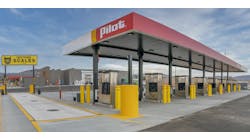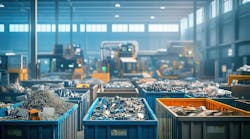ZF on clean vehicle transition, AV development, and more
ZF, as the world’s largest commercial vehicle and passenger car supplier, faces serious challenges in the transition to zero-emissions vehicles, and the solutions will be found through collaboration—between OEMs, suppliers, and customers; between industry and policy makers; and even between nations, Peter Laier, ZF Group board member responsible for the ZF Commercial Vehicle Solutions division, explained in an interview following his on-stage presentation during the IAA media day.
“One thing which is worrying us is that we need to have stable regulations for the transition of the industry,” Laier told Fleet Maintenance affiliate FleetOwner. “We would like to have more technology openness instead of regulation, or incentivization instead of regulation.”
He cited specifically the need for alternative fueling infrastructure.
“That means the charging infrastructure for battery electric vehicles—and, please keep in mind, charging infrastructure for commercial vehicles is different than for passenger cars—we have to have the grid. And also with H2—combustion engine or fuel cell—we need to have an infrastructure,” he said. “It's maybe not needed at the beginning to have that all over the countries, but on the important routes. We would appreciate a much closer dialog between the industry and politicians to find solutions for the challenge of decarbonization and transformation.”
Incentives vs. mandates
Regarding the different paths to clean CVs in Europe and the U.S., Laier gave the nod to the U.S.
“What I think is great in North America is that it's not so much about regulation, it's more about incentivization to approach emission reduction technology—which is, I think, a good approach.” Laier said.
Electrified trailers will work in US
The TrailTrax system for trailer electrification, ultimately, will provide a range of benefits for customers, he suggested in the media interview with North American journalists.
“We can leverage with the electrification of trailer further opportunities in the industry,” he said. “What we do is we go beyond what others are doing: We are not only recuperating energy in the trailer, we actively drive it. And that is absolutely valid for the North American market, where we think the combination of a diesel truck and electrified trailer is a kind of hybrid vehicle which you can create.”
Read more: Range electric trailer powers 4-mpg improvement, MVTS study finds
He did point out that trailers are used in a variety of ways in the North American markets, and not all applications or fleet utilization strategies would be suited for the added investment in trailer electrification. But the demand will grow where the technology makes sense.
“There are more and more customers in the North American market which are demanding CO2 reduction in transportation, and an e-trailer can contribute heavily,” Laier said. “That's why we are quite convinced it will play an important role in the U.S. and we are working very actively to find a solution.”
Wabco integration a success
Regarding the integration of Wabco into the ZF product portfolio, Laier called the acquisition “a perfect fit.”
“We are now the powerhouse of commercial vehicle supply, and I mean powerhouse not only based on size: We are the technology driver and innovation driver in the industry, and Wabco acquisition has helped us a lot,” he noted.
AV development costly
Regarding vehicle autonomy, Laier suggested that self-driving trucks were just emerging from the Gartner Hype Cycle’s “trough of disillusionment”—meaning the hard work is now being done on real-world development after the initial excitement about potential has run its course.
“You see that specifically in China and in North America,” Laier said, noting that weather conditions are favorable on seven or eight of the top 10 transportation routes in the U.S.—meaning the opportunity is there. “One thing is clear: We are in an TCO Total Cost of Ownership driven industry. And the use case and the business case for automated driving is clear.
“The biggest problem we have as an industry is we all thought, in commercial vehicles, that you can derive technology out of passenger car, and customize it for commercial vehicle needs, because of the huge investment which is necessary and the economies of scale. Now, we see that in passenger car it's going slower than expected, and we need to find solutions within the industry, OEMs and suppliers—and we are working on that. But that slows down the introduction [of autonomous trucks] because of the heavy investing.”
This article was originally published on FleetOwner.com.



